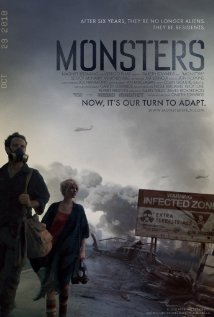 MONSTERS (2010 directed by Gareth Edwards)
MONSTERS (2010 directed by Gareth Edwards)
The sci-fi film Monsters (2010, dir. Gareth Edwards) recently completed its run in Australian cinemas. The film starts six years after a US space mission crashed in Mexico, releasing its cargo of alien monsters. The massive monsters wreak havoc but the US and Mexican military’s air strikes and chemical weapons have only managed to contain them in about half of Mexico, an area now called the ‘Infected Zone’. The monsters are especially active during their mating season and all forms of travel between South and North America ceases for six months. The film’s protagonists, Samantha Wynden (Whitney Able) and Andrew Kaulder (Scoot McNairy), arrive at a border port to try to return to the US but miss the last ferry out and must travel by road through the Infected Zone to reach home.
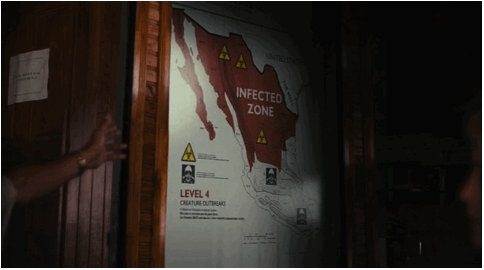
Monsters was made on a small budget – the online rumours vary between US$15,000 (Hill, 2010) to US$500,000 (Horn, 2010). Low budget feature filmmaking in itself is neither new nor interesting – filmmakers have always found ways to make work with few resources. But what is interesting is the relation between the current prodigious trend towards low budget filmmaking and the crisis in mainstream film industries, especially Hollywood. The years 2008/9 saw personnel shake-ups in the major studios (Earth Times, 2009). Since the GFC, much of Hollywood’s traditional funding from investment banks and hedge funds have dried up (FilmFundingSources.com, n.d.). Studios, which are used to dictating terms, now have to rely on funding from private investors who are less interested in insecure projects. Most studios are now producing remakes and sequels. Traditional distribution patterns are no longer as lucrative due to falling cinema attendances and DVD sales. Low budget filmmaking is thus emerging as the viable, low-risk, (potentially) high-return option. Paramount is in the process of setting up a division catering solely to producing projects with a budget of less than US$100,000 (Horn, 2009).
Monsters is a textbook example of low-budget film-making. It had a total (principal) cast of two – the rest of the film was made up of extras from the shooting locations in Central America. The crew during filming comprised of Edwards, who directed and shot the film, a sound recordist, a line-producer, a translator, an editor and assistant editor. The lean cast and crew size ensured that the film unit was mobile and flexible. The unit travelled in a van, scouting locations and trying out scenes when they found somewhere suitable (Hart, 2010). Involving editors during shooting to review and catalogue shots was an inspired move. Because the film is largely unscripted, Edwards had to overshoot. This is usually risky. Many unscripted and improvised films suffer from a lack of dramatic tension. Monsters was edited into a taut drama.
Edwards used a number of effective strategies, bequeathed from the histories of world cinema, that help filmmakers make work with minimal resources. Locating the film in a real environment and using people who actually live and work in that environment as characters was common in Italian neo-realism. Shooting in Latin America may have been economically prudent, but the way the film interacted with the local people and locations bestowed it with documentary realism. The hand held shooting, using small, mobile cameras, moving quickly between locations, having planned scenes but not scripted dialogue, allowing the dynamism of the shoot to impact the final film and the collaborative nature of the film-making are all reminiscent of the methods of the French New Wave’s filmmakers, such as Jacques Rivette, and of more recent filmmakers including Gus Van Sant. Edwards’ contribution to this tradition is the way he has employed and integrated inexpensive digital tools into low-budget filmmaking and achieved a measure of recognition for it. This is not to suggest that he is a trailblazer, but what he has achieved has occurred at a propitious historical moment.
The adoption of any technology is always mediated and conditioned by social and economic factors. The late fifties and early sixties saw the widespread use of smaller, handheld film-cameras in filmmaking. Cameras designed and manufactured by Auricon in the US and Eclair in France, capable of handheld work, had been around a decade earlier but were rarely used until the late fifties (Salt, 1983: 290 & 313). The move towards more immediate, experimental filmmaking was perhaps a reaction against the post-war economic boom and to new social movements that were emerging in the world.
Digital video (DV) cameras have been on the market since the mid nineties. While their use was widespread in almost every mode of media production, including television, documentary and user-generated media production, the mainstream film industry never truly adopted it. The complaint was that DV had narrow colour space and poor resolution with too few pixels per line that won’t stand to being projected in a cinema. More importantly, it did not have that elusive ‘film-look’. The introduction of High Definition (HD) cameras in the late 1990s changed the situation somewhat. HD had better resolution, but despite a few notable examples of feature films shot on HD, such as Russian Arkin 2001, most feature films were still shot on film stock. Early HD cameras were also too prohibitively expensive to be used by low budget filmmakers.
However, the social, economic and technological situation is very different today. HD cameras are a fraction of what they used to cost. The Sony PMWEX3 on which Monsters was shot costs under A$8,000. But what has really been a game changer is the introduction of 35mm adapters that could give these digital cameras the much desired ‘film look’. As it turns out, the ‘film look’ is simply shallow depth of field where the principle element of a shot is in focus while the background is out of focus. It was difficult to achieve shallow depth of field with digital video cameras due to their small image sensors and inferior lenses. One of the strengths (or in this case, weakness) of video images is their deep focus look where most of the image is in focus. This is why video is suited to many forms of documentary making.
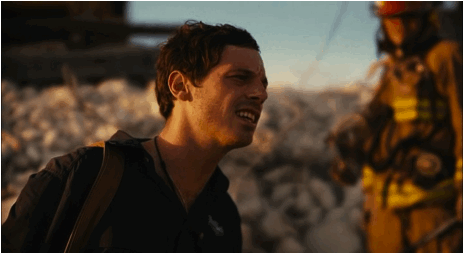
A 35mm adapter (or sometimes also called a depth of field adapter) allows a 35mm movie or stills camera lens to be mounted to a digital video camera. The adapter is placed between the 35mm lens and the camera’s image sensor. Thus, irrespective of its own chip size, the image the camera records bears the full characteristics of a 35mm lens. The aperture on the 35mm lens can be opened to further increase the effect of shallow depth of field. The shallow depth of field look is also why Digital SLRs capable of shooting HD video are now becoming popular in filmmaking. As some of these cameras, notably the Canon EOS 5D Mark II, have a full 35 mm image sensor and use 35mm lenses, shallow depth of field can be had without a need for a 35mm adapter and for a much cheaper price than a HD video camera.
Edwards used relatively cheap Nikon still camera lenses with the Letus 35mm adapter on the Sony PMWEX3 HD camera. The camera is what is termed as a ‘prosumer’ camera – a category of cameras that are aimed at the intermediate, serious-hobbyist market – between the professional and the home-user markets. The shallow depth of field shots in Monsters assisted the character-driven drama by keeping the focus on the protagonists. The shallow depth of field of the shots must have also saved time during post-åproduction as it meant that the drawn-in elements that Edwards created and added to the backgrounds could be a little less than perfect.
For picture post-production, Edwards and his editor, Colin Goudie, used standard PCs running the Adobe Production Suite, in particular Premier, Photoshop and After Effects. These tools are ubiquitous in the industry and were used seamlessly in an integrated workflow. Goudie would edit on Premier while Edwards would work on the visual effects in After Effects without the need of rendering the Premier sequence. The work done in After Effects would be directly linked to the sequence in Premier.
Unlike big budget Sci-Fi films that are normally shot in a studio in front of a chroma screen allowing for the background to be easily removed and replaced, Monsters was completely shot on location. Edwards kept the backgrounds but added visual effects elements to them. These elements were used in place of live production design. For example, all the signage in the film such as ‘Infected Zone’ or ‘Danger’, were designed in Photoshop and composited into the scene with After Effects. Monsters is not overburdened by its special effects. This simple and effective strategy of using the actual backgrounds with added visual effects elements augmented the documentary realism of the film. The post-apocalyptic world that Edwards conjures is menacing as it is the world we inhabit.
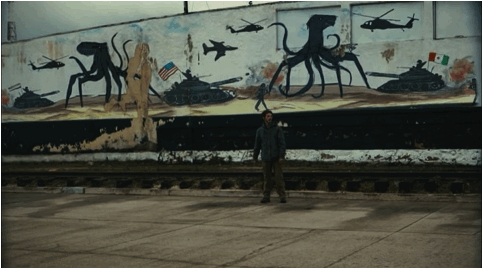
Monsters is not a radical film in form or content, but unlike many other Sci-Fi films, it is also not a mindless spectacle that glorifies violence, war and heroism. The film is admirable for its lack of histrionics. The hysteria of the 24-hour news, which repeats reports of monster attacks between nature docos on the monsters, is contrasted in the film with the acquiescence of the people who live in the danger zone.
It is not difficult to read a critique of the US as a failing military state in the film. The detritus of this failure pervades the film – sunken navy vessels, parts of military aircraft on a horse-drawn cart, perhaps on the way to be sold for scrap. When Sam and Kaulder arrive at the colossal concrete wall, what is now the border between Mexico and the US, it is unguarded and abandoned. There are no immigrants scrambling to enter. The first human settlement at which Sam and Kaulder arrive in the US is in ruins. It was filmed in post-Hurricane Ike Galveston, but in the film Kaulder says it had been destroyed by an air strike.
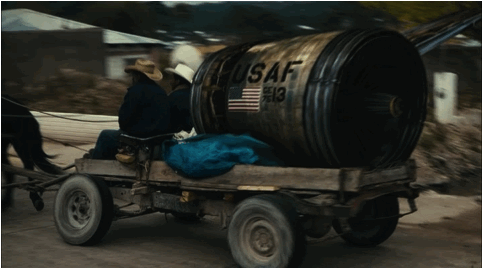
Critiques of the US as a military-industrial state are commonplace, even in mainstream cinema. But Monsters extends the critique. Not only is the military unable to wipe out the monsters, its presence aggravates the situation. US helicopters and planes anger the monsters and cause them to react with heightened ferocity. At the port where Sam and Kaulder attempt to board a ferry, a van with a megaphone drives past protesting military action. Edwards has stated in multiple interviews that he is referencing the US war on terror (Davis, 2010; Wotzke, 2010). Nick Turse and others argue in The case for withdrawal from Afghanistan (2010),that the US military is exacerbating the situation in Afghanistan and hindering peace efforts. Malalai Joya, one of Afghanistan’s leading democracy activists, stated in 2009 that in eight years, the US and its allies have killed less than two thousand Taliban but over eight thousand civilians (Goodman, 2009). The recent Wikileaks release of US State Department cables reveal how US military drone strikes are destabilizing Pakistan and increasing the risk of a nuclear incident (Branfman, 2011).
Despite making a successful low-budget film, ultimately Edwards’ vision is limited by his attitude to filmmaking. Unlike filmmakers who make low budget films as resumes for big budget studio work, Edwards has worked in the mainstream industry and understands how its processes are cumbersome and to the detriment of creativity. Edwards extols the virtue of low budget filmmaking, but notwithstanding his contortions, is only able to see ‘real’ filmmaking as Hollywood studio filmmaking (Wotzke, 2010). In a gesture that debases his efforts on Monsters, he claims, “if you want that career where you make movies, then you've got to have a 20, 30 million dollar PR campaign behind you” (Lambie, 2010). It is unsurprising to hear that Edwards’ next project is a remake of the Godzilla franchise with Warner Brothers (Barr, 2011).
Of all the arts, film is the art form that is most imbricated in capital and the Hollywood studio its avatar – it expresses itself as the only mode of production. Inspired by Taylorist principles of scientific management, Thomas Ince, the progenitor of the studio system developed the continuity script in 1913. The aim of the continuity script is to “separate the conception and production phases of film-making” (Staiger, 1979: 18). This was the way he ensured that those who worked for him did not deviate from his standardized model of filmmaking. A version of the continuity script is still being used today.
Low budget filmmaking uses strategies such as employing cutting edge and inexpensive tools and working collaboratively through ignoring the strictures of division of labour and of the division between intellectual and physical labour. However these strategies alone are insufficient to enable it to think itself beyond Hollywood studio filmmaking. The promise of low budget filmmaking is nothing less than the resistance to the domination of capital in a space where capital thinking reigns. But it will never fulfill its promise if it sustained only by necessity and not by possibility and commitment.
Stills captured from DVD of Monsters. See reference below for details.
References
Branfman, F. (2011, January 16). WikiLeaks Revelation: How US Policy in Pakistan Heightens the Risk of Nuclear Attack. Alternet. Retrieved from http://www.alternet.org/world/149547/wikileaks_revelation%3A_how_us_policy_in_pakistan_heightens_the_risk_of_nuclear_attack?page=entire
Davis, L. (2010, December, 2). Interview with Gareth Edwards, the Director of ‘Monsters’. The Independent. Retrieved from http://blogs.independent.co.uk/2010/12/02/interview-with-gareth-edwards-the-director-of-‘monsters’/
Earth Times. (2009, October 8). Horror in Hollywood reflects an industry in crisis. Earth Times. Available from http://www.earthtimes.org/articles/news/289187,horror-in-hollywood-reflects-an-industry-in-crisis--feature.html
Edwards, G. (Director). (2011). Monsters [DVD]. New York: Magnolia Home Entertainment.
FilmFundingSources.Com. (n.d.). Hedge Fund Financing – Are We Watching A Fundamental Shift In Strategy? Retrieved from http://filmfundingsources.com/hedge-fund-financing-–-are-we-watching-a-fundamental-shift-in-strategy/
Goodman, A. (2009, October 28). "A Woman Among Warlords": Afghan Democracy Activist Malalai Joya Defies Threats to Challenge US Occupation, Local Warlords. Democracy Now.
Retrieved from http://www.democracynow.org/2009/10/28/a_woman_among_warlords_afghan_democracy
Hart, H. (2010, September 16). Monsters‘ Lo-Fi Sci-Fi Draws Heavily on Reality. Wired. Available from http://www.wired.com/underwire/2010/09/monsters/
Hill, R. (2010). A Monster Movie – Without a Monster Budget. Nerd Bastards. Retrieved from http://nerdbastards.com/2010/09/15/a-monster-movie-without-a-monster-budget/
Horn, J. (2010, October 28). Chasing 'Monsters,' on a budget. Los Angeles Times. Available from http://articles.latimes.com/2010/oct/28/entertainment/la-et-word-20101028
Horn, J. (2009, December 10). Paramount to launch micro-budget movie division. Los Angeles Times. Available from http://latimesblogs.latimes.com/entertainmentnewsbuzz/2009/12/paramount-to-launch-microbudget-movie-division.html
Lambie, R. (2010, November 29). Gareth Edwards interview: on making Monsters, meeting Quentin Tarantino and more. Den of Geek. Retrieved from http://www.denofgeek.com/movies/687301/gareth_edwards_interview_on_making_monsters_meeting_quentin_tarantino_and_more.html
Salt, B. (1983). Film style and technology : history and analysis. London: Starworld.
Staiger, J. (1979). Dividing Labor for Production Control: Thomas Ince and the Rise of the Studio System. Cinema Journal, Vol. 18, No. 2, Economic and Technological History (Spring, 1979). 16-25.
Turse, N. (Ed). (2010). The case for withdrawal from Afghanistan. London: Verso
Wotzke, A (2010). Interview: MONSTERS director Gareth Edwards (Audio). cutprintreview. Available from http://cutprintreview.com/interviews/interview-monsters-director-gareth-edwards-audio/
About the Reviewer
Iqbal Barkat is a filmmaker and a PhD candidate at the Centre for Cultural Research, University of Western Sydney.
Contact: i.barkat@uws.edu.au

